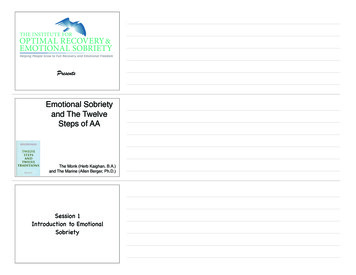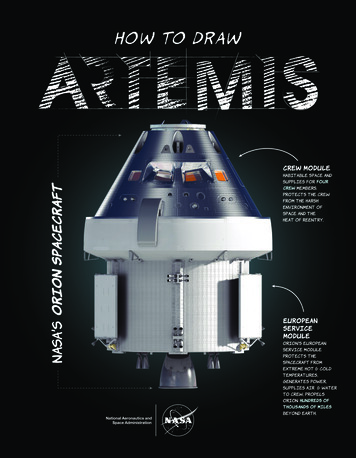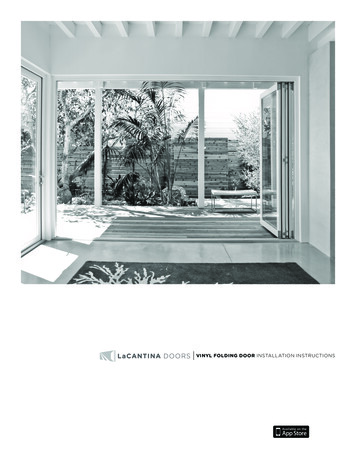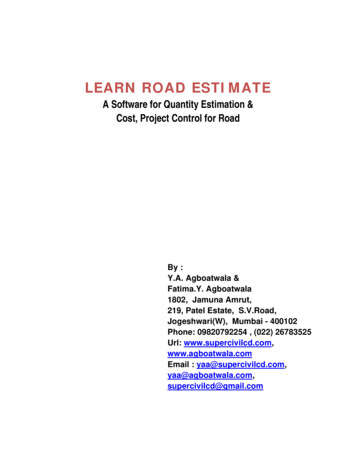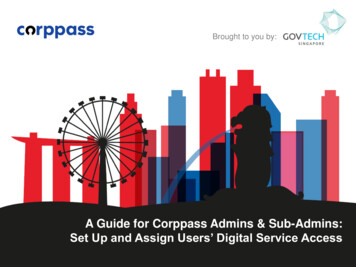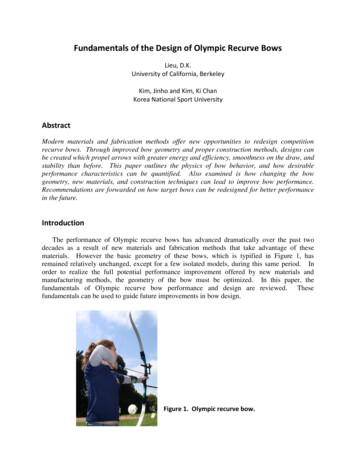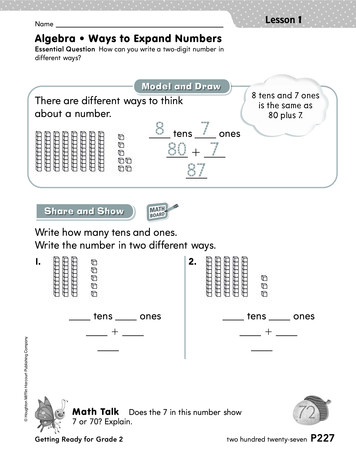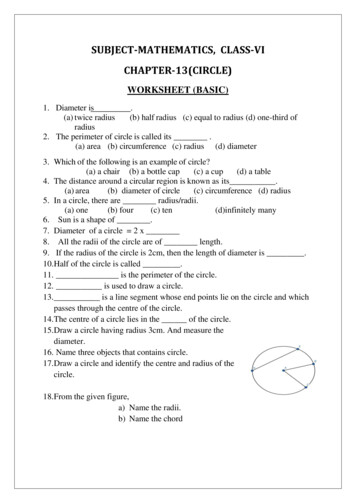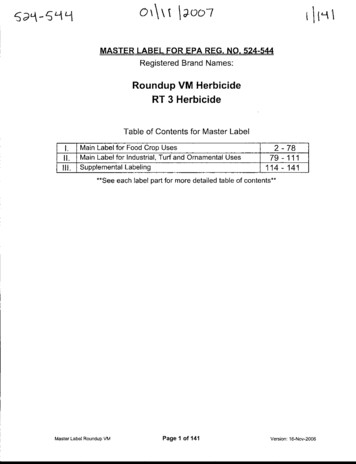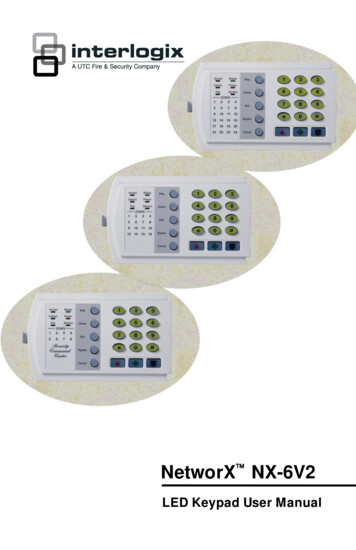
Transcription
OFFICIAL RULEBOOK
DeckbuildingQuick ReferenceThere are only a few rules you need to follow when building your deck: Your deck must include at least 60 cards, not counting your startinghero. Your hero starts the game in play, and it isn’t considered a partof your deck. You can’t include more than four copies of a single card in your deckunless that card has “unlimited” in its type line. You may include anynumber of unlimited cards in your deck. Some ability cards can only be used by a hero who has a certaintalent spec. Those cards will have “[Talent Spec] Hero Required” inbold in their text box. You can include only cards that share one or more trait iconswith your hero in your deck. Some neutral cards don’t have anytrait icons. You can put those cards into any deck.Check out the WoW TCG websites: UDE.com/wow, WoWRealms.com, WoWCards.org,WoW.TCGPlayer.com, WarcraftCCG.com, WoWTCGDB.com
TableofIntroduction. 1ContentsGame Overview. 1 Object of the Game. 2What’s in the Starter Box. 2About This Rulebook. 2Traits. 3 Parts of a Card. 5 Basic Game Terms. 6 .1.2.3.4.5.6.Ready and ExhaustResourcesCostsPowersTargetUniquenessGame Zones. 9 .Card Types. 11 uest. 17 Turn Sequence. 18 1.2.3.Start Phase Action Phase End PhaseBasic Combat.21 1.2.3.The Combat StepCombat with a HeroProtecting in CombatKeywords.22 Deckbuilding.24Advanced Concepts.25The Chain and Responding.25 1.2.3.The ChainResponding ResolvingDamage .281.2.3.4.Sources and Types of DamageHealing Damage Preventing DamageArmorMultiplayer Rules.30Sealed Pack Formats.31Glossary.32.Credits .39Quick Reference Rules.44
IntroductionWelcome to the World of Warcraft trading card game!In this game, you control a hero in the world of Azeroth. As you play, your hero can invite allies tojoin your party, complete quests, find weapons and armor, and play abilities and talents directlyfrom the World of Warcraft online game.The World of Warcraft TCG draws from the rich lore of the Warcraft universe. Two factions arebattling for supremacy over Azeroth—the Horde and the Alliance—and each time you play, youchoose a hero from one of these factions to represent you.This TCG was created by loyal World of Warcraft fans and the best trading card game designers inthe world. We hope you enjoy it!Game OverviewTrading card games (TCGs) are different from other games in two ways. First, the cards in a TCGcan change or go beyond the game’s basic rules. The card is always right. That means you shouldalways do what the card says—even if the rules say something different.Second, you get to choose the cards you want to play in your deck. You decide which hero to play,what items and abilities you will use, which allies you will invite into your party, and what questsyou will perform. In this game, you have total control over the power of your deck.1
Object of the GameIn the World of Warcraft TCG, you control a hero. Your hero is the leader of your party who fightsalongside your allies. The cards that you play will allow you to equip your hero with weapons andarmor, use spells and talents, invite allies into your party, and complete quests.The object of the game is to defeat your opponents before they defeat you. Over the course ofthe game, your hero and allies will deal damage toyour opponents’ heroes and allies, and that damageis permanent unless it is healed. If your hero takesdamage equal to or greater than his or her health, you’reout of the game.You’re also out of the game if you run out of cards inyour deck and can’t draw another card, so you mustdefeat your opponents before that happens.Deal 27 damage to this hero, and you win.What’s in the Starter Box?Each starter box contains: A deck of 30 cards, wrapped together with a herocard and two UDE Points cards. The deck has beenpreconstructed to go with its hero card. You’ll playyour first few games with this deck and its hero.There are 9 different starter decks, one for each class. Two booster packs of additional cards. Feel free toopen them up, but don’t mix them with thepreconstructed deck yet. Three random oversize hero cards. You can use thesecards in games, or just collect them.About This RulebookThe rest of this rulebook is divided into three parts: game rules, advanced concepts, and theglossary. The game rules will tell you everything you need to know to start playing the World ofWarcraft TCG. You can reference the glossary or advanced concepts section whenever you wish.For comprehensive tournament rules, visit www.ude.com/wow.2
TraitsWhat a hero can do in the World of Warcraft TCG is determined by his or her traits. Your hero hasfive traits: faction, talent spec, professions, race, and class. FACTION: The war between the Horde and the Alliance has settled into a tenuous peace.While open warfare may be over, the hostility is not, and skirmishes often break out betweenthe two sides.The Alliance: The Alliance is made up of four races: the noble humans of Stormwind, themysterious night elves of Darnassus, the mighty dwarves of Ironforge, and the gnomes,refugees of the irradiated city of Gnomeregan. They are bound by ties of loyalty datingback to the Second War, when they fought side by side to defeat the Horde. In addition, thedraenei will be featured in the TCG’s second set.The Horde: The races of the new Horde came together under Warchief Thrall in the wakeof the Second War and the flight to Kalimdor. The Horde is made up of the bloodthirstyorcs, the Darkspear trolls, the noble tauren, and the Forsaken, undead who broke free oftheir enslavement to the Lich King. You’ll also find a sneak peek of the blood elves in thefirst set. TALENT SPEC: Each hero specializes in a talent tree. Your hero’s talent spec is located on thehero card as shown here:Talent SpecProfessions PROFESSIONS: Each hero has two professions, which will be important in future Worldof Warcraft TCG expansions. Future sets will include cards like Glimmering Mithril Insignia forBlacksmiths and Smoking Heart of the Mountain for Enchanters. RACE: In future World of Warcraft TCG expansions, there will be cards that can be used only bymembers of a certain race. For example, the Undead will have a Cannibalize card. CLASS: All nine classes are represented in the TCG.Druid: Keepers of the natural order of the world, druids can shape-shift into differentanimal forms. They harness the power of nature to heal their allies and harm theirenemies. Druids have powerful spells to help themselves and their friends, such asMark of the Wild and Innervate. In this first TCG set, Druids will have access to bearform. More forms will be added with each set.3
Hunter: Hunters are deadly marksmen who share a special bond with the beasts ofAzeroth. Hunters have access to powerful offensive cards like Aimed Shot, Aspect ofthe Hawk, Multi-Shot, and Rapid Fire. There are four Hunter Pets in this first TCG setand many more in upcoming sets.Mage: Masters of the arcane arts, mages have access to powerful direct damage andarea of effect spells that can disable many enemies at once. Their offense from thisfirst TCG set includes cards such as Fire Blast, Frostbolt, Flamestrike, and Pyroblast.Mages can utilize tricks like Blink, Counterspell, Frost Nova, and Polymorph to outlasttheir opponents despite their lower starting health.Paladin: These upholders of the Light are powerful fighters and solid healers.Their unwavering pursuit of justice makes them stalwart defenders of the Alliance.Paladins are very powerful as heroes or as allies in your party. Paladins have offensivecapabilities with cards such as Blessing of Might, Hammer of Justice, and RetributionAura, and defensive capabilities with cards such as Blessing of Protection, Cleanse,Devotion Aura, and Divine Shield.Priest: The priests of Azeroth are spread across many races and faiths, but all sharepowerful healing abilities. Those who lean toward shadow have great power to meltfaces, while those who specialize in holy pursuits are incredible healers. In this firstTCG set, Priests have access to a wide range of offensive, defensive, and utilitycards, including Dispel Magic, Flash Heal, Mind Blast, Mind Control, Prayer of Healing,Psychic Scream, and Shadowform.Rogue: Masters of stealth and subtlety, rogues are deadly assassins. Theycomplement their skills in combat with a seemingly endless arsenal of tricks. Roguesin the TCG have access to Poisons, stealth, Combo cards, and Finishing Moves.Cards in the first set include Backstab, Cold Blood, Crippling Poison, Expose Armor,Premeditation, and Sinister Strike.Shaman: Shamans have an arsenal of weapons at their disposal along with healingspells and totems that buff the entire party. In this first TCG set, Shamans have cardssuch as Chain Lightning, Earthbind Totem, Ghost Wolf, Purge, Windfury Totem, and themighty Frost Shock.Warlock: Warlocks channel demonic energies to destroy their enemies with curses,DOTs, and the most powerful debuffs in the game. Warlocks have access to four usefulPets in the first TCG set, with more upcoming in future sets. Some key Warlock spellsfrom the first set include Life Tap, Rain of Fire, Shadow Bolt, Fear, and Curse of Agony.Warrior: The masters of melee combat. As tanks or damage dealers, warriors aremost at home in the thick of battle. Warriors have access to the most weapons, armor,and shields. They are the best tanking class, which is represented by the protectorability in the TCG. Some Warrior cards in the first set include Battle Shout, Charge,Demoralizing Shout, Execute, Last Stand, Mortal Strike, Shield Bash, and Sunder Armor.4
Parts of a CardWorld of Warcraft TCG cards have: A card name A play cost in the upper left corner, which tells you how many resources you must exhaust toplay the card from your hand. Trait icons, which are used when you construct your deck. (See the “Traits” and“Deckbuilding” sections for more information.) A type line between the art and the text box, which tells you what type of card it is. A card’stype line may have one or more tags (such as “Pet” or “Axe”) that other cards may reference. A text box under the type line, which tells you the card’s powers. A collector number that tells you the card’s number within the set and what set it’s from. Thecolor of the collector number also tells you the card’s rarity: white for common, green foruncommon, blue for rare, purple for epic, and orange for legendary.Play CostNameType LineTrait IconsCollector Number5Card Power
Basic Game Terms1. Ready and ExhaustWhen a card enters play, it starts out in the ready position, as shown here.ReadyExhaustedAt the start of each of your turns, you ready all of your cards in play.When you want to use a card in play, you usually exhaust it. To exhaust a card, turn it sideways asshown. You can only exhaust a card that’s ready.2. ResourcesResources are like currency in this game. You exhaust resources to pay the costs of various actions,such as inviting allies into your party or using your hero’s abilities.On each of your turns, you may choose any card from your hand to place (put into play) as aresource. To place a resource, put it into play in your resource row. (See the “Game Zones” sectionfor more information.) Quests can be placed face up; other cards can only be placed face down.3. CostsA cost is anything you must pay to play a card, use a power, or perform any other game action.Resource costs on a card or power are represented by a number within the resource costsymbol. You pay a resource cost by exhausting that number of resources. For example, a cardthat you must exhaust two resources to play will have a 2 in its upper left corner, and a powerthat you must exhaust two resources to use will have a 2 as part of its cost.6
4. PowersThe text in a card’s text box tells you that card’s powers. Read the text and follow the instructions touse the card’s power. Many powers have costs to use them.5. TargetIf a card tells you to target something, you must choose one target. If a card tells you to target morethan one thing, you must choose that number of targets.Example: You play an ability that reads, “Exhaust target ally.” You play the card and choose oneally your opponent controls. Your opponent exhausts that ally.You must choose the target as you play that card. If there is no legal target (a target in play that fitsthe description given on the card), you can’t play that card.Once you choose a target, you can’t change your mind, even if something happens to the target youpicked.6. UniquenessSome cards have the “unique” keyword on their type line. Any time you control more than one uniquecard in play with the same name, you must put all but one of them into their owners’ graveyards.You choose which one to keep. This happens as soon as more than one copy of the same uniquecard are in play on your side.7
Some cards have a tag on their type line followed by a number in parentheses. That number tellsyou how many cards with that tag you can control at the same time. Any time you control more thanthat number of cards with that tag, you must immediately put all but that number of them into theirowners’ graveyards. You choose which to keep.Example: Searing Totem has the Fire Totem (1) tag as shown here. This meansyou can have only one Fire Totem in play. Any time you have more than one FireTotem in play, you must immediately put all but one of them into their owners’graveyards. You choose which one to keep.Only heroes, unique cards, and cards with restricting tags (as shown above) have limits on how manyyou can have in play on your side. For example, you can have more than one copy of the ally GrintSundershot in play at the same time, because Grint Sundershot does not have the “unique” keyword.Some cards have the tag “Two-Handed” followed by a weapon type (such as Axe) on their type line.You can’t have both a Two-Handed weapon and a card with the “Off-Hand” tag (usually an item,weapon, or armor) in play at the same time. Any time you control a Two-Handed weapon and anOff-Hand card, you must immediately put one of them into its owner’s graveyard. You choose whichone to keep.Note that all Two-Handed weapons have the “Melee (1)” tag, so you can’t control both a Two-Handedweapon and another Melee weapon at the same time. However, you can control both a Melee weaponand a Ranged weapon at the same time. Dual-wielding will be introduced in upcoming sets.8
Game ZonesYour cards can be in any one of six game zones. Each player has a deck zone, a hand zone, agraveyard zone, and a removed from game zone. All players share the chain zone and the play zone.While you’re playing a game, your zones will look something like this:9
You shuffle your deck and allow your opponent to cut it before each game starts. During agame, cards in your deck are face down, and you can’t look through any player’s deck. Your hand is where you hold the cards you draw. Only you get to see the cards in your hand. Your graveyard is where your “dead” cards go. Cards that have been destroyed or discardedgo into your graveyard. Cards in a graveyard are face up, and you can look through anyplayer’s graveyard. The chain is where cards and effects go after you play them but before they have an impacton the game. You don’t need to know more about the chain until you get to the advancedconcepts section. The play zone is where most of the game’s action happens. Allies, weapons, armor, items,resources, and ongoing abilities enter play here. Each player has an ally row for allies; a herorow for weapons, armor, items, ongoing abilities, and his or her hero; and a resource rowfor resources. To see where the different types of cards belong in the play zone, look at thediagram on the facing page. The removed from game zone is where players put cards that have been removed from thegame. The removed from game zone isn’t the same as the graveyard, so cards in the removedfrom game zone aren’t accessible by cards like Resurrection, for example.10
Card Types1. HeroYour hero card represents you, the leader of your party.Each hero has a health value printed in the lower right corner, which tells you how much damage thehero can take. If your hero takes damage greater than or equal to his or her health (fatal damage),you’re out of the game.Your hero can attack and defend against opposing heroes and allies, but to deal damage in combat,you usually must strike with a weapon. Your hero can also use armor and items to help in combat.Each hero card has a type line with several traits on it. You can find your hero’s race, talent spec,and class on the left side of the type line. Your hero’s professions are on the right side of the typeline. Each hero also has a faction trait icon in the upper left corner and a class trait icon in theupper right corner.Each hero card is two-sided. You start the game with the side that has the trait icons on it face up.During the game, you may use your hero’s power, which causes the hero to be flipped over to the sidethat has full artwork.Hero Card FrontHero Card Back2911Graccus
2. AllyAt the start of the game, your party contains only your hero, but as the game progresses you mayinvite allies to join your party. Allies can attack and defend against opposing heroes and allies, andmany of them have powers that you can use during the game. You can attack with an ally or use itsthe start of your turn.powers only if it has been in your party sinceWhen you play an ally, it enters play in your ally row.Each ally card has: A play cost in the upper left corner, which tells you how many resources you must exhaust toplay the card from your hand. An attack value (or ATK) in the lower left corner, which tells you how much damage the allydeals in combat. There’s also a symbol around the ATK that tells you what kind of combatdamage the ally deals. While the kind of combat damage dealt has no impact on the game,other cards may refer to it.These are the eight damage symbols:ArcaneFireFrostHolyMeleeNatureRangedShadow A health value in the lower right corner, which tells you how much damage the ally cantake. An ally that takes fatal damage (damage equal to or greater than its health) is destroyedand goes to its owner’s graveyard.CostNameType LineRestrictionATKHealth12
3. WeaponWeapon cards can only be used by your hero and only if your hero’s class matches one of the classicons on the weapon card. Weapons and other equipment in the TCG use the “common sense”method of class restriction. Therefore, Warriors won’t be able to use equipment intended for casters,and vice versa. For example, in the TCG Warriors can’t equip a Mooncloth Robe or an Inventor’sFocal Sword. Likewise, a Mage can’t equip a Krol Blade or Heartseeker.Your hero starts the game with no ATK, but while your hero is in combat, you may strike with aweapon to increase your hero’s ATK for the combat. You can only strike with one weapon during acombat, but you can strike with that weapon multiple times if you can find a way to ready it. If youstrike with a weapon multiple times in the same combat, you add its ATK to your hero’s each timeyou strike.Your hero doesn’t have to be attacking to strike with a weapon. You can also strike with a weapon ifyour hero is defending. If you have two weapons (one Melee and one Ranged, for example), you canstrike with one while your hero is attacking. Then, when your hero is attacked, you can strike withthe other weapon.Even if your hero is exhausted, you can still strike with a weapon.If your weapon leaves play after you’ve struck with it, your hero gets to keep the ATK bonus for theduration of the combat.When you play a weapon card, it enters play in your hero row. To strike with a weapon in play, pay itsstrike cost and exhaust it. You can strike with a weapon on the same turn that you play it. You canuse a weapon’spowers on the same turn that it enters play.Play CostATK13Strike Cost
Each weapon card has: A play cost in the upper left corner, which tells you how many resources you must exhaust toplay the card from your hand. A strike cost in the lower right corner, which tells you how many resources you must exhaust tostrike with the weapon. An ATK in the lower left corner, which tells you how much ATK the weapon gives your hero forthe combat when you strike with it. There’s also a symbol around the ATK that tells you whatkind of damage a hero deals when he or she strikes with the weapon.4. ArmorArmor cards can only be used by your hero and only if your hero’s class matches one of the classicons on the armor card.Armor can be used to prevent damage that would be dealt to your hero. When you play an armorcard, it enters play in your hero row. To use an armor in play, you exhaust it.You can use an armor’spowers on the same turn that it enters play.Each armor card has: A play cost in the upper left corner, which tells youhow many resources you must exhaust to play the cardfrom your hand.A defense value (or DEF) in the lower right corner. Anytime damage would be dealt to your hero, you mayexhaust an armor to prevent damage equal to its DEF.To learn more about using armor, see “Armor” in the “Damage”section.DEF14
5. ItemItem cards can only be used by your hero andonly if your hero’s class matches one of theclass icons on the item card.Items are the gear your hero can have inaddition to weapons and armor. Rings, Trinkets,and Potions are examples of items.When you play an item card, it enters play inyour hero row.You can use an item’sturn that it enters play.powers on the sameEach item card has: A play cost in the upper left corner, whichtells you how many resources you mustexhaust to play the card from your hand. A power in its text box.6. AbilityAbilities are cards that represent your hero’s special skills and magical spells.Each ability card has a play cost in the upper leftcorner, which tells you how many resources you mustexhaust to play the card from your hand.Most abilities go to your graveyard when you play them,but abilities with the “ongoing” keyword in their textbox enter play. The text after the word “ongoing” tellsyou what the ability’s powers are while it’s in play.Ongoing Power15
Ability cards can only be played during the action phase on your turn unless they have the “instant”tag on their type line. Instant abilities can be played any time, including during your opponent’s turn.If an ongoing ability tells you to attach it toa card in play, you put the ability underneaththat card as the ability enters play. When acard leaves play, each ability attached to thatcard goes to its owner’s graveyard.AttachedMore than one ongoing ability can beattached to the same card—evenabilities with the same name. 7. QuestQuests enter play only as resources. When you choose a quest card to place as a resource, you canput it into play face up. While a quest is face up in your resource row, you can pay costs with it likeyou would with a face-down resource (by exhausting it), and you can also use its powers.Example: You have a quest face up in your resource row that reads, “Pay 3 tocomplete this quest. Reward: Draw a card.” If you exhaust three resources andflip this quest face down, you draw a card. (Note that you can exhaust the questitself to pay part of the resource cost.) Once flipped, a quest stays face down inyour resource row. You can still use it as a resource to pay costs, but you can’t useits power again because it’s no longer face up.Quest PowerOnce you complete a quest, you must flip the card face down to show that it’s been completed.Quests have an exclamation point instead of a play cost in the upper left corner.16
SetupYou should play your first few games with the hero and preconstructed deck that came in thestarter box. Remember, don’t mix the cards in your booster packs with the preconstructed deck yet.The only other things you need to play are counters to represent damage and other card effects. Youcan track counters on a card with dice, beads, or other small items. Use counters to keep track ofhow much damage your hero and each of your allies has taken. Remember that damage on a hero orally is permanent unless the damage is healed or the ally leaves play.Each player starts by putting his or her hero into play. Then, flip a coin to decide who goes first.After shuffling, each player draws an opening hand of seven cards.Starting with the first player, each player who doesn’t like his or her opening hand can mulligan. Tomulligan, shuffle your opening hand of cards into your deck and then draw a new opening hand ofseven cards. Each player can mulligan only once each game, and only at the start of the game.Example: Your opening hand contains seven ability cards, each with cost 5 orgreater. You know that if you keep that opening hand, you probably won’t be ableto do anything for the first few turns of the game, so you decide to mulligan.After each player has settled on an opening hand, the first player’s turn starts.17
Turn SequencePlayers take turns, going clockwise from the first player. Each player’s turn is divided into threephases, and some phases are divided into steps.1. Start PhaseYour start phase is when you get ready for a new turn. It’s divided into two steps: the ready stepand the draw step.Ready StepAt the beginning of your ready step, you ready (turn upright) all your cards in play.Draw StepAt the beginning of your draw step, you draw a card.On the first player’s first turn, he or she doesn’t draw a card.18
2. Action PhaseDuring your action phase, you may perform any of four actions in any order: play a card, use apayment power, place a resource, and propose a combat.You may place only one resource a turn, but you may perform each of the other actions as manytimes as you’d like.a. Play a CardTo play a card, take it from your hand, pay its play cost (the number in the upper left corner) byexhausting that number of your resources, and follow the instructions in its text box.Once you’ve done that: If the card is a weapon, armor, or item, it enters play beside your hero. If it’s an ally, it enters play in your ally row. If it’s an ability that attaches to a card, it enters play underneath that card. If it’s an ongoing ability that doesn’t attach to a card, it enters play in yourhero row.If it’s a non-ongoing ability (an ability that doesn’t have the “ongoing”keyword), it goes to your graveyard.b. Use a Payment PowerA payment power is any power on a card that has an arrow symbol ( ) in its text. The textbefore theis the cost to use the payment power, and the text after theis what happenswhen you do. To use a payment power, pay its cost and then do whatever the text after thesays to do.Unless the card says otherwise, you can use a payment power as many times as you’d like, aslong as you can afford to pay the cost each time.) as part of their cost. To pay that cost,Some payment powers have an activate symbol (exhaust the card that the power is on. These powers are called activated powers. Remember, youcan use an ally’s activated power only if that ally has been in your party since the start of yourturn. You can use an armor, item, or weapon’s activated power on the same turn that itenters play.c. Place a ResourceYou may place one resource on each of your turns. To place a resource, take any card from yourhand and put it face down into your resource row. If the card is a quest, you may choose to putit into your resource row face up. If you do, you can use its powers once it’s in play.d. Propose a CombatYour hero and allies can attack your opponents’ heroes and allies. You’ll learn about howcombat works in the “Basic Combat” section.19
3. End PhaseAfter you’re done playing cards, using payment powers, placing a resource, and proposingcombats, you move into your end phase.During your end phase: You can no longer place a resource, propose combats, or play cards other than instants.Any player may play instants or use powers.Once all players have performed the actions they want to do, you move into your wrap-up step.During your wrap-up step, if you have more cards in hand than the maximum hand size (sevencards), you must discard until you have only the maximum hand size.After a player’s wrap-up step is over, the next player begins his or her start phase.20
Basic Combat1. The Combat StepIn a basic combat, five things happen in order:1. Propose: You choose a ready hero or ally in your party to be the proposed attacker and anopposing hero or ally to be the proposed defender.2. Attack: Your proposed attacker exhausts (turns sideways) and attacks.3. Defend: The proposed defender starts defending.4. Damage: The attacker and defender deal combat damage to each other equal to their ATKs. Thisis the only damage that counts as combat damage.5. Conclude: The combat step ends.There are other things that can happen in a combat if the attacker or defender is a hero or if thedefending player controls a hero or ally that can protect, but for now, let’s look at an example of acombat between two allies.Example: You propose an ally in your party to attack one of your opponent’sallies. Your proposed attacker has 2 ATK and 3 health, and the proposed defenderhas 1 ATK and 2 health. You exhaust your attacker. When the combat concludes,your attacker deals 2 combat damage to the defender, and the defender deals 1combat damage to your attacker. The defender is destroyed because it has takenfatal damage. Your attacker gets a
This TCG was created by loyal World of Warcraft fans and the best trading card game designers in the world. We hope you enjoy it! Game Overview Trading card games (TCGs) are different from other games in two ways. First, the cards in a TCG can change or go beyond the game's basic rules. The card is always right. That means you should

